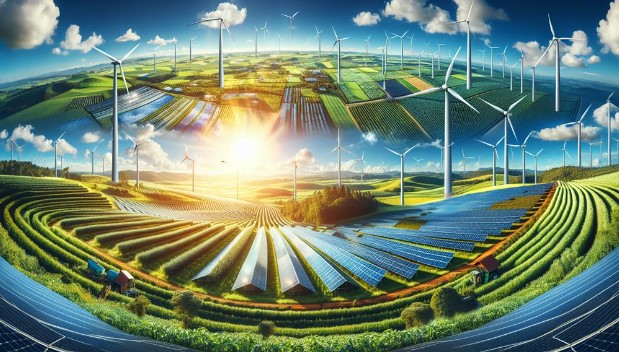Imagine you’re a farmer in rural Iowa, where rolling fields meet the horizon, and you’ve just leased part of your land for a wind turbine project. By integrating renewable energy production with traditional farming, you’re not only securing a steady additional income but also participating in a movement that promises environmental sustainability. This innovative approach can potentially reshape rural economies and the energy sector. However, what might be the broader implications for the agricultural community and the global energy landscape? Engage in this discussion to explore how such initiatives could influence future farming practices and energy policies.
The Growing Trend of Farmland Leasing
Lease farm land for renewable energy projects is rapidly gaining traction as a sustainable and profitable strategy for landowners and investors alike. As you consider the potential of your land, it’s essential to recognize how integrating renewable energy, such as solar or wind farms, can harmonize with traditional agricultural practices, promoting land conservation and maintaining soil integrity.
You might wonder how renewable installations coexist with your current land use. Here’s the key: strategic placement and careful planning ensure that land remains productive. Solar panels, for example, can be erected in less optimal areas for cultivation, allowing more fertile sections to continue supporting crop rotation. This method not only preserves the agricultural value of the land but also enhances soil recovery and protection by reducing overuse in single areas.
Moreover, the dual use of land for both energy generation and agriculture minimizes the ecological footprint of both activities. By leasing parts of your farmland for renewables, you’re not just generating income; you’re also contributing to a broader sustainability agenda. This approach ensures that land conservation isn’t compromised but rather integrated into a larger, profitable framework of modern, sustainable agriculture.
Benefits to Farmers
Exploring the benefits to farmers, you’ll find that leasing your land for renewable energy projects not only diversifies income but also secures long-term financial stability. Engaging in such agreements provides a steady, reliable source of revenue, which can be particularly vital during fluctuating market conditions and unpredictable weather patterns that impact traditional farming income.
Moreover, integrating renewable energy installations, such as solar panels or wind turbines, into your land management strategy can lead to enhanced soil health. These installations typically occupy only a fraction of your land, offering you the opportunity to continue agricultural activities around them. This setup allows for effective crop rotation strategies, crucial for preventing soil degradation. By rotating crops and not having to rely solely on agricultural output, you reduce the risk of exhausting soil nutrients, thus maintaining soil fertility and structure.
This approach not only preserves the quality of your land but also positions you as a leader in sustainable farming practices, attracting potential premium markets that value environmental stewardship. Furthermore, the additional income from leasing can fund investments in modern, sustainable agricultural techniques, further enhancing your farm’s productivity and ecological footprint. Thus, leasing land for renewable energy projects isn’t just financially advantageous—it’s a proactive step towards a sustainable farming future.
Impact on Renewable Energy Production
Farmland dedicated to renewable energy projects significantly boosts overall production capacities, directly contributing to a more sustainable energy grid. By transitioning portions of agricultural land to support wind turbines and solar panels, you’re not only maximizing underutilized space but also leveraging technological innovations that elevate energy outputs. These projects harness natural resources effectively, reducing reliance on fossil fuels and addressing pressing environmental concerns.
With the integration of advanced tracking and adaptive technologies, solar installations on farmland can achieve higher efficiency rates. This isn’t about replacing agriculture; it’s about creating a dual-use scenario where farming and energy production coexist synergistically. You’ll find that these innovative practices don’t just mitigate the environmental impacts traditionally associated with energy production; they set a new standard for it.
Moreover, the strategic placement of renewable energy technologies in rural farmland areas taps into less obstructed wind patterns and unshaded land, enhancing energy capture. It’s clear that leveraging farmland for renewable purposes isn’t just an alternative – it’s a necessary evolution in our energy strategy. This approach aligns with global sustainability goals, empowering communities, conserving resources, and leading the charge towards a cleaner, more resilient energy infrastructure. By supporting these transitions, you’re at the forefront of a crucial shift, championing both technological advancement and environmental stewardship.
Types of Renewable Energy Projects
Building on the integration of renewable energy in agricultural settings, various project types offer unique advantages and opportunities. Solar farms, for example, are tremendously scalable. You can start small, powering a single facility, and expand to generate enough energy for thousands of homes. Technological advancements in photovoltaic panels mean they’re now more efficient and less obtrusive than ever.
Wind projects are another viable option. With today’s taller, more efficient turbines, you can harness stronger winds at higher altitudes, maximizing output while minimizing land use. These turbines can be spaced out between crop fields or grazing land, ensuring that your farm’s productivity isn’t compromised.
Biomass energy projects convert agricultural waste into power, solving waste disposal issues while generating energy. Technological advancements have streamlined these processes, making them cleaner and more efficient.
Each type of project offers you a way to diversify your income and contribute to a sustainable future. Think of renewable energy projects not just as an addition to your farm, but as an integral part of its evolution. With careful planning, the scalability of these projects ensures they grow alongside your agricultural operations, adapting to technological advancements and market demands.
Legal and Financial Considerations
Before you commit to a renewable energy project on your farm, it’s crucial to understand the legal requirements and financial implications involved. You’ll need to navigate a complex web of legal considerations, ensuring compliance with both local and federal regulations. It’s not just about setting up solar panels or wind turbines; it’s about understanding zoning laws, environmental impact assessments, and potential legal liabilities.
One key area you can’t overlook is the contract duration. These agreements often last 20 to 30 years, locking you into long-term commitments that will affect your land and possibly your financial future. Make sure you’re comfortable with the timeframe and that the terms are flexible enough to account for changes in technology or your personal circumstances.
Tax implications are another critical aspect. Renewable energy installations can lead to significant tax benefits, including deductions, credits, and depreciations. However, these benefits can vary widely depending on your location and the specifics of the project. You’ll want to consult with a tax professional who can provide detailed advice based on your particular situation.
Case Studies: Successful Implementations
Exploring case studies reveals how some farmers have successfully integrated renewable energy projects, yielding substantial sustainability and economic benefits. Let’s focus on a particular example: a mid-sized farm in Iowa that shifted part of its land to solar energy production. Initially, the transition faced local resistance due to concerns about landscape changes and potential environmental impacts. However, the farm’s proactive engagement with the community, including educational workshops and transparent communication, turned skepticism into support.
This farm not only overcame the hurdle of local resistance but also addressed environmental concerns by implementing a solar project designed to coexist with local wildlife, preserving natural habitats. The solar panels were strategically placed to minimize land use and were paired with native vegetation that supports local biodiversity.
The technical aspect of this project involved state-of-the-art photovoltaic cells that efficiently capture solar energy without extensive land disruption. This setup not only provided the farm with a stable, additional income stream but also significantly cut down on carbon emissions.
Your takeaway? You can navigate local resistance and environmental concerns effectively. By prioritizing community engagement and sustainable practices, you too can transform your farm into a model of renewable energy success, securing both ecological and economic resilience.
Future Outlook and Expansion Opportunities
As you consider expanding your renewable energy initiatives, it’s crucial to assess both emerging technologies and evolving market demands to maximize future growth opportunities. You’ll need to stay ahead of global policies that shape the renewable sector. Nations are increasingly implementing stricter environmental regulations and offering investment incentives to encourage sustainable practices. Leveraging these policies can significantly enhance the viability and profitability of your projects.
Investment incentives are particularly key. They not only reduce your initial capital expenditure but also improve the long-term financial outlook of your renewable projects. You should focus on regions where these incentives are most attractive, aligning your expansion efforts with areas that support environmental innovation through fiscal benefits.
Moreover, technological advancements in solar and wind energy promise greater efficiency and lower costs. You must integrate these innovations swiftly to stay competitive. Consider partnerships with tech companies to gain early access to next-gen technologies.




